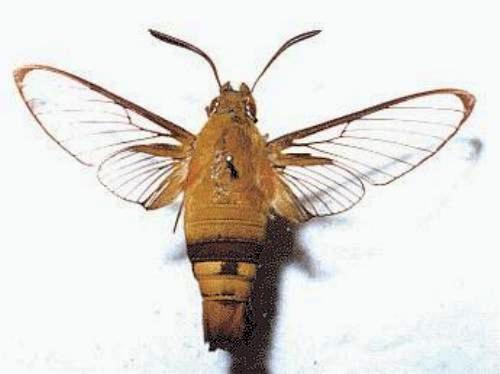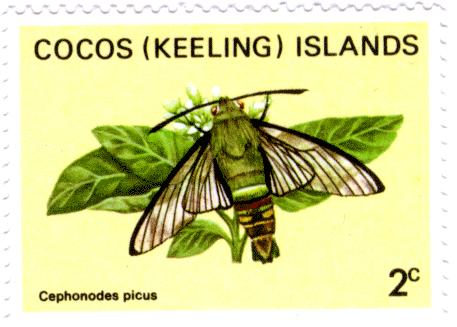
| Cunningham's Bee Hawk (previously known as Sesia cunninghami) MACROGLOSSINAE, SPHINGIDAE, BOMBYCOIDEA | (donherbisonevans@yahoo.com) and Stella Crossley |

(Specimen: courtesy of Graeme Cocks,
Townsville, Queensland)

| Cunningham's Bee Hawk (previously known as Sesia cunninghami) MACROGLOSSINAE, SPHINGIDAE, BOMBYCOIDEA | (donherbisonevans@yahoo.com) and Stella Crossley |

(Specimen: courtesy of Graeme Cocks,
Townsville, Queensland)
The Caterpillars of this species are initially greyish green, with a harmless black forward curving tail spike. Later instars may become grey or brown or stay green, and develop red circles around the spiracles, and a pale dorso-lateral line along each side of the back. The last instar has a backward curving tail spike, and a red border to the upper side of each pale dorso-lateral line
The caterpillars have been found feeding on a variety of plants in RUBIACEAE including:
The caterpillars rest along the mid-vein on the underside of a leaf, and eat the leaf each side of this vein before moving on to the next leaf. The caterpillars can reach a length of 6 cms.
The pupa is brown, and formed in a loose silk cocoon in the leaf litter, or under the soil if it is friable, to a depth down to 8 cms. The pupa has a length of about 3.5 cms.

The adult moths soon lose the scales from the wings, leaving them transparent. The moths then resemble Bumble Bees, hence the name 'Bee Hawks' for the moths in this genus Cephonodes.
The wings have uniformly narrow opaque edges. The abdomen is brown with a dark band across one abdominal segment, and a dark dorsal mark on the adjacent segment. The moths have a wingspan of about 5 cms.

The species (listed as Cephonodes picus) has been found in
as well as in Australia in
The eggs are spherical and green. They are laid randomly, usually singly, often under leaves and on buds of a foodplant.
The adult moth is easily confused with Cephonodes australis, with the main superficial differences being a single spike (rather than several tiny spikes) at the distal end of the fore-tibia, and a pale yellow (rather than white) underside to the thorax.
Further reading:
Maxwell S. Moulds, James P. Tuttle and David A. Lane.
Hawkmoths of Australia,
Monographs on Australian Lepidoptera Series, Volume 13 (2020),
pp. 76-79, Plates 11, 78, 85.
Francis Walker,
Sphingidae,
List of the Specimens of Lepidopterous Insects in the Collection of the British Museum,
Part 8 (1856), p. 85, No. 10.
 caterpillar |  butterflies |  Lepidoptera |  moths |  caterpillar |
(updated 21 December 2009, 17 September 2025))